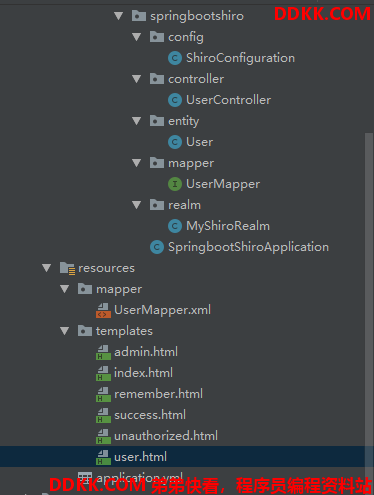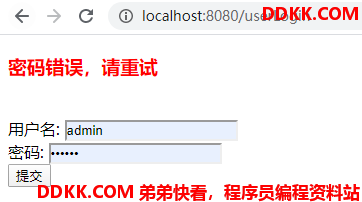一、概述
前面一篇文章,我们已经总结了Shiro相关的一些概念以及架构知识,相信小伙伴们对Shiro安全框架都有了一定的认识。本篇文章我们将通过示例详细说明在日常工作中常见的-----用户身份认证功能。
什么是身份认证呢,简单理解,就是在应用中谁能证明他就是他本人。一般提供如他们的身份 ID 一些标识信息来表明他就是他本人,如提供身份证,用户名 / 密码来证明。
在shiro 中,用户需要提供 principals (身份)和 credentials(证明)给 shiro,从而应用能验证用户身份:
1、 principals:身份,即主体的标识属性,可以是任何东西,如用户名、邮箱等,唯一即可。一个主体可以有多个 principals,但只有一个 Primary principals,一般是用户名 / 密码 / 手机号。
2、 credentials:证明 / 凭证,即只有主体知道的安全值,如密码 / 数字证书等。
最常见的 principals 和 credentials 组合就是用户名 / 密码。
接下来,我们以SpringBoot为基础,通过整合Shiro来实现用户身份认证功能。
二、身份认证流程
在Spring Boot中集成Shiro进行用户的认证过程主要有以下三点:
1、 定义一个ShiroConfig,然后配置SecurityManager,SecurityManager是Shiro的安全管理器,管理着所有Subject;
2、 在ShiroConfig中配置ShiroFilterFactoryBean,其为Shiro过滤器工厂类,依赖于SecurityManager;
3、 自定义Realm实现;
接下来,我们创建一个SpringBoot项目:【springboot-shiro】,整体项目结构如下图所示:

前提:我们先创建一个 数据库shiro,然后创建一张用户表user并初始化一条用户信息,表sql如下:
CREATE TABLE user (
id varchar(32) COLLATE utf8_bin NOT NULL COMMENT '用户id',
username varchar(64) COLLATE utf8_bin NOT NULL COMMENT '用户名',
password varchar(32) COLLATE utf8_bin NOT NULL COMMENT '用户密码',
status char(1) COLLATE utf8_bin DEFAULT '1' COMMENT '用户状态',
PRIMARY KEY (id) USING BTREE
) ENGINE=InnoDB DEFAULT CHARSET=utf8 COLLATE=utf8_bin ROW_FORMAT=COMPACT
并初始化一条用户信息:
INSERT INTO user VALUES ('1', 'admin', '123456', '1');
【a】引入一些相关的依赖:mysql、mybatis、thymeleaf、shiro等。具体pom.xml如下:
<?xml version="1.0" encoding="UTF-8"?>
<project xmlns="http://maven.apache.org/POM/4.0.0" xmlns:xsi="http://www.w3.org/2001/XMLSchema-instance"
xsi:schemaLocation="http://maven.apache.org/POM/4.0.0 https://maven.apache.org/xsd/maven-4.0.0.xsd">
<modelVersion>4.0.0</modelVersion>
<parent>
<groupId>org.springframework.boot</groupId>
<artifactId>spring-boot-starter-parent</artifactId>
<version>2.2.10.RELEASE</version>
<relativePath/> <!-- lookup parent from repository -->
</parent>
<groupId>com.wsh.springboot</groupId>
<artifactId>springboot-shiro</artifactId>
<version>0.0.1-SNAPSHOT</version>
<name>springboot-shiro</name>
<description>Demo project for Spring Boot</description>
<properties>
<java.version>1.8</java.version>
</properties>
<dependencies>
<dependency>
<groupId>org.springframework.boot</groupId>
<artifactId>spring-boot-starter-web</artifactId>
</dependency>
<dependency>
<groupId>org.apache.shiro</groupId>
<artifactId>shiro-spring-boot-web-starter</artifactId>
<version>1.4.0</version>
</dependency>
<dependency>
<groupId>org.springframework.boot</groupId>
<artifactId>spring-boot-starter-thymeleaf</artifactId>
</dependency>
<dependency>
<groupId>org.mybatis.spring.boot</groupId>
<artifactId>mybatis-spring-boot-starter</artifactId>
<version>1.3.3</version>
</dependency>
<dependency>
<groupId>mysql</groupId>
<artifactId>mysql-connector-java</artifactId>
<scope>runtime</scope>
</dependency>
<dependency>
<groupId>org.springframework.boot</groupId>
<artifactId>spring-boot-starter-test</artifactId>
<scope>test</scope>
<exclusions>
<exclusion>
<groupId>org.junit.vintage</groupId>
<artifactId>junit-vintage-engine</artifactId>
</exclusion>
</exclusions>
</dependency>
</dependencies>
<build>
<plugins>
<plugin>
<groupId>org.springframework.boot</groupId>
<artifactId>spring-boot-maven-plugin</artifactId>
</plugin>
</plugins>
</build>
</project>
【b】定义User实体类,接口UserMapper外加上UserMapper.xml配置实现
public class User {
private String id;
private String username;
private String password;
private String status;
public String getId() {
return id;
}
public void setId(String id) {
this.id = id;
}
public String getUsername() {
return username;
}
public void setUsername(String username) {
this.username = username;
}
public String getPassword() {
return password;
}
public void setPassword(String password) {
this.password = password;
}
public String getStatus() {
return status;
}
public void setStatus(String status) {
this.status = status;
}
}
UserMapper.java:
@Mapper
public interface UserMapper {
/**
* 根据用户名查找用户信息
*
* @param name 用户名
* @return
*/
User findUserByName(@Param("name") String name);
}
UserMapper.xml:
<?xml version="1.0" encoding="utf-8"?>
<!DOCTYPE mapper
PUBLIC "-//mybatis.org//DTD Mapper 3.0//EN"
"http://mybatis.org/dtd/mybatis-3-mapper.dtd">
<mapper namespace="com.wsh.springboot.springbootshiro.mapper.UserMapper">
<resultMap type="com.wsh.springboot.springbootshiro.entity.User" id="baseUser">
<id column="id" property="id" javaType="java.lang.String" jdbcType="VARCHAR"/>
<id column="username" property="username" javaType="java.lang.String" jdbcType="VARCHAR"/>
<id column="password" property="password" javaType="java.lang.String" jdbcType="VARCHAR"/>
<id column="status" property="status" javaType="java.lang.String" jdbcType="VARCHAR"/>
</resultMap>
<select id="findUserByName" resultMap="baseUser" parameterType="String">
SELECT * FROM USER t
where t.username ={name}
</select>
</mapper>
【c】配置文件 application.yml,配置数据源信息、mybatis扫描的包等
server:
port: 8080
spring:
datasource:
driver-class-name: com.mysql.jdbc.Driver
username: root
password: root
url: jdbc:mysql://localhost:3306/shiro?serverTimezone=UTC&useUnicode=true&characterEncoding=utf-8
mybatis:
mapper-locations: classpath:mapper/*Mapper.xml
type-aliases-package: com.wsh.springboot.springbootshiro.entity
configuration:
log-impl: org.apache.ibatis.logging.stdout.StdOutImpl
【d】自定义Realm,通过继承AuthenticatingRealm 实现
需要重写doGetAuthenticationInfo方法。
package com.wsh.springboot.springbootshiro.realm;
import com.wsh.springboot.springbootshiro.entity.User;
import com.wsh.springboot.springbootshiro.mapper.UserMapper;
import org.apache.shiro.authc.*;
import org.apache.shiro.realm.AuthenticatingRealm;
import org.slf4j.Logger;
import org.slf4j.LoggerFactory;
import org.springframework.beans.factory.annotation.Autowired;
public class MyShiroRealm extends AuthenticatingRealm {
private static final Logger logger = LoggerFactory.getLogger(MyShiroRealm.class);
@Autowired
private UserMapper userMapper;
/**
* 认证相关方法
*/
@Override
protected AuthenticationInfo doGetAuthenticationInfo(AuthenticationToken authenticationToken) throws AuthenticationException {
UsernamePasswordToken usernamePasswordToken = (UsernamePasswordToken) authenticationToken;
//1.判断用户名, token中的用户信息是登录时候传进来的
String username = usernamePasswordToken.getUsername();
char[] password = usernamePasswordToken.getPassword();
logger.info("username:" + username);
logger.info("password:" + new String(password));
//通过账号查找用户信息
User user = userMapper.findUserByName(username);
if (null == user) {
logger.error("用户不存在..");
throw new UnknownAccountException("用户不存在!");
}
if ("0".equals(user.getStatus())) {
throw new LockedAccountException("账号已被锁定,请联系管理员!");
}
//数据库中查询的用户名
Object principal = user.getUsername();
//数据库中查询的密码
Object credentials = user.getPassword();
String realmName = getName();
//2.判断密码
return new SimpleAuthenticationInfo(principal, credentials, null, realmName);
}
}
【e】创建Shiro的全局配置类
import com.wsh.springboot.springbootshiro.realm.MyShiroRealm;
import org.apache.shiro.spring.web.ShiroFilterFactoryBean;
import org.apache.shiro.web.mgt.DefaultWebSecurityManager;
import org.springframework.beans.factory.annotation.Qualifier;
import org.springframework.boot.web.servlet.FilterRegistrationBean;
import org.springframework.context.annotation.Bean;
import org.springframework.context.annotation.Configuration;
import org.springframework.web.filter.DelegatingFilterProxy;
import java.util.LinkedHashMap;
import java.util.Map;
/**
* @Description: Shiro全局配置类
* @author DDKK.COM 弟弟快看,程序员编程资料站
* @Date: 2022/11/3 09:23
* <p>
* 三大组件:
* 1. Subject: 用户主体(把操作交给SecurityManager)
* 2. SecurityManager:安全管理器(关联Realm)
* 3. Realm:Shiro连接数据的桥梁
*/
@Configuration
public class ShiroConfiguration {
/**
* 将Realm注册到securityManager中
*
* @return
*/
@Bean("securityManager")
public DefaultWebSecurityManager securityManager() {
return new DefaultWebSecurityManager(myShiroRealm());
}
/**
* 配置自定义的Realm
*/
@Bean
public MyShiroRealm myShiroRealm() {
return new MyShiroRealm();
}
/**
* 如果没有此name,将会找不到shiroFilter的Bean
* <p>
* Shiro内置过滤器,可以实现权限相关的拦截器
* 常用的过滤器:
* anon: 无需认证(登录)可以访问
* authc: 必须认证才可以访问
* user: 如果使用rememberMe的功能可以直接访问
* perms: 该资源必须得到资源权限才可以访问
* role: 该资源必须得到角色权限才可以访问
*/
@Bean
public ShiroFilterFactoryBean shiroFilter(@Qualifier("securityManager") DefaultWebSecurityManager securityManager) {
ShiroFilterFactoryBean shiroFilterFactoryBean = new ShiroFilterFactoryBean();
shiroFilterFactoryBean.setSecurityManager(securityManager);
//表示指定登录页面
shiroFilterFactoryBean.setLoginUrl("/userLogin");
//登录成功后要跳转的链接
shiroFilterFactoryBean.setSuccessUrl("/success");
//未授权页面
shiroFilterFactoryBean.setUnauthorizedUrl("/unauthorized");
//拦截器, 配置不会被拦截的链接 顺序判断
Map<String, String> filterChainDefinitionMap = new LinkedHashMap<>();
//所有匿名用户均可访问到Controller层的该方法下
filterChainDefinitionMap.put("/index", "anon");
filterChainDefinitionMap.put("/userLogin", "anon");
//authc:所有url都必须认证通过才可以访问; anon:所有url都都可以匿名访问
filterChainDefinitionMap.put("/**", "authc");
shiroFilterFactoryBean.setFilterChainDefinitionMap(filterChainDefinitionMap);
return shiroFilterFactoryBean;
}
/**
* SpringShiroFilter首先注册到spring容器
* 然后被包装成FilterRegistrationBean
* 最后通过FilterRegistrationBean注册到servlet容器
*
* @return
*/
@Bean
public FilterRegistrationBean delegatingFilterProxy() {
FilterRegistrationBean filterRegistrationBean = new FilterRegistrationBean();
DelegatingFilterProxy proxy = new DelegatingFilterProxy();
proxy.setTargetFilterLifecycle(true);
proxy.setTargetBeanName("shiroFilter");
filterRegistrationBean.setFilter(proxy);
return filterRegistrationBean;
}
}
【f】在resource/templates文件夹下创建几个html文件:
index.html:
<!doctype html>
<!--注意:引入thymeleaf的名称空间-->
<html lang="en" xmlns:th="http://www.thymeleaf.org">
<head>
<meta charset="UTF-8">
<meta name="viewport"
content="width=device-width, user-scalable=no, initial-scale=1.0, maximum-scale=1.0, minimum-scale=1.0">
<meta http-equiv="X-UA-Compatible" content="ie=edge">
<title>Document</title>
</head>
<body>
<h3 style="color: red" th:text="${msg}"></h3><br/>
<form method="post" action="/userLogin">
用户名: <input type="text" name="username"><br/>
密码: <input type="password" name="password"><br/>
<input type="submit" name="submit"><br/>
</form>
</body>
</html>
success.html:
<!doctype html>
<!--注意:引入thymeleaf的名称空间-->
<html lang="en">
<head>
<meta charset="UTF-8">
<meta name="viewport"
content="width=device-width, user-scalable=no, initial-scale=1.0, maximum-scale=1.0, minimum-scale=1.0">
<meta http-equiv="X-UA-Compatible" content="ie=edge">
<title>Document</title>
</head>
<body>
你好,这是登录成功的页面<br/>
</div>
</body>
</html>
unauthorized.html:
<!doctype html>
<!--注意:引入thymeleaf的名称空间-->
<html lang="en" xmlns:th="http://www.thymeleaf.org">
<head>
<meta charset="UTF-8">
<meta name="viewport"
content="width=device-width, user-scalable=no, initial-scale=1.0, maximum-scale=1.0, minimum-scale=1.0">
<meta http-equiv="X-UA-Compatible" content="ie=edge">
<title>Document</title>
</head>
<body>
抱歉,你暂未授权访问此页面
</body>
</html>
【g】编写UserController
package com.wsh.springboot.springbootshiro.controller;
import org.apache.shiro.SecurityUtils;
import org.apache.shiro.authc.IncorrectCredentialsException;
import org.apache.shiro.authc.LockedAccountException;
import org.apache.shiro.authc.UnknownAccountException;
import org.apache.shiro.authc.UsernamePasswordToken;
import org.apache.shiro.subject.Subject;
import org.slf4j.Logger;
import org.slf4j.LoggerFactory;
import org.springframework.stereotype.Controller;
import org.springframework.ui.Model;
import org.springframework.web.bind.annotation.GetMapping;
import org.springframework.web.bind.annotation.RequestMapping;
import org.springframework.web.bind.annotation.RequestMethod;
@Controller
public class UserController {
private static final Logger logger = LoggerFactory.getLogger(UserController.class);
@GetMapping("/index")
public String index() {
//返回index.html
return "index";
}
@GetMapping("/success")
public String success() {
return "success";
}
@RequestMapping(value = "/userLogin", method = RequestMethod.POST)
public String toLogin(String username, String password, Model model) {
//1.获取Subject
Subject subject = SecurityUtils.getSubject();
//2.封装用户数据
UsernamePasswordToken token = new UsernamePasswordToken(username, password);
try {
//3.执行登录方法
subject.login(token);
//4.登录成功,然后跳转到success.html
return "redirect:/success";
} catch (UnknownAccountException e) {
logger.error("msg:该账号不存在");
model.addAttribute("msg", "该账号不存在");
return "index";
} catch (IncorrectCredentialsException e) {
logger.error("msg: 密码错误,请重试");
model.addAttribute("msg", "密码错误,请重试");
return "index";
} catch (LockedAccountException e) {
logger.error("msg:该账户已被锁定,请联系管理员");
model.addAttribute("msg", "该账户已被锁定,请联系管理员");
return "index";
} catch (Exception e) {
model.addAttribute("msg", "登录失败");
logger.error("msg: 登录失败");
return "index";
}
}
@RequestMapping("/unauthorized")
public String unauthorized() {
return "unauthorized";
}
}
【h】主启动类
@SpringBootApplication
@MapperScan("com.wsh.springboot.springbootshiro.mapper")
public class SpringbootShiroApplication {
public static void main(String[] args) {
SpringApplication.run(SpringbootShiroApplication.class, args);
}
}
【i】启动项目,进行测试
浏览器访问:http://localhost:8080/index,输入admin/123456:

可以看到,因为此时用户名和密码跟数据库中是一致的,所以登录成功,并跳转到success.html中。

重新访问http://localhost:8080/index,输入admin11111/123456,如下图:

可以看到,由于用户表中不存在此用户,所以提示账号不存在。
重新访问http://localhost:8080/index,输入admin/111111,如下图:

可见,当输入错误的密码时,shiro提示密码错误。
三、总结
以上就是关于Shiro提供了用户身份认证功能,总结一下大体步骤:
- 自定义Realm,继承AuthenticatingRealm ,重写方法doGetAuthenticationInfo(AuthenticationToken authenticationToken),通过subject.login方法传入的token,去数据库中查询用户数据,将用户密码传入shiro进行比对;
- 自定义Shiro配置,注入SecurityManager安全管理器、ShiroFilterFactoryBean过滤器工厂等对象;
存在问题:在实际工作中,密码不可能明文传输,为了演示方便,上面的示例使用的明文密码比对,实际上Shiro也提供了加密功能,下一篇文章我们将优化成密文比对。